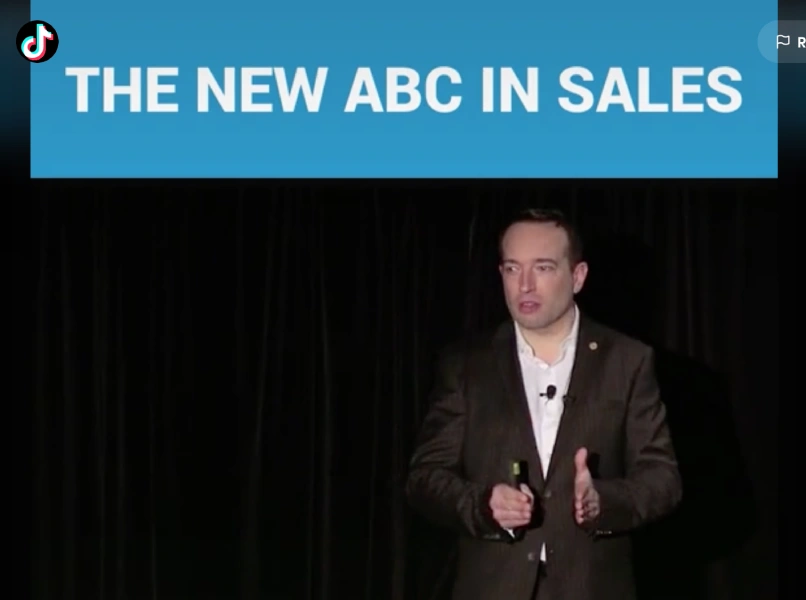Sales Leadership Podcast – leading behavioural change through coaching and powerful questions
Podcast: Play in new window | Download | Embed
Subscribe: RSS
This sales podcast episode is on the fundamentals of sales leadership with focus on behavioural change and sales coaching. I have taken the transcript from the sales podcast episode and am providing it below with minimal formatting or grammatical changes. It’s rather conversational but I’m providing it to those of you who prefer to read or want to highlight specific statements. It’s based upon the lessons I have accumulated working with sales organizations and delivering leadership training programs over the past 20+ years. Following is the full video version of this Podcast and below that is the transcript:
Here’s the transcript:
Transcript for “Sales Leadership – leading behavioural change through coaching and powerful questions”
I’m shifting to both video and audio, so you’ll be able to find the video of this podcast on YouTube. But I’m also going to be sharing those on my Sales Academy website as well. You can find that at Salesacademy.ca.
So, my goal, of course, is to take this content I’m creating in my podcast and distribute it further and in different mediums depending on how you like to learn. I’m also going to be throwing these onto my Instagram channel @ShaneGibson and my TikTok channel @ShaneGibsonLive if you want to access this content in sound bites versus a long podcast.
Today, I’m going to focus on the fundamentals of coaching skills as well as the coaching process for sales leaders in particular. Now, if you’re a salesperson listening to this and you start to check the boxes around what your leader isn’t doing for you, this is really not what it’s about. In no organization is the coaching process perfect. It’s constantly evolving. And sometimes, as a salesperson, you have to step up to the plate and proactively seek that coaching from your peers and your sales leader in your organization. By no means is this meant to be an exhaustive list of criteria you should use to judge whether your leader is any good, but rather an indication of what gaps exist in your organization and where you might need to seek help. And of course, for sales leaders, I’m hoping this gives you a foundation to build upon, so you can have a more solid process in your sales coaching.
The Future of Sales Leadership – Coaching, Technology, and Management Skills
Let’s talk about leadership in general. Sales leadership, first and foremost, is all about driving results. And at the end of the day, driving results is often about behavioral change. So, as a sales leader, the better you become at sales leadership, the better you really are at driving behavioral change, whether it’s in your leaders, if you’re managing a group of sales managers, or your direct line salespeople, if you’re a sales manager yourself. Leadership truly builds people who then build the business. That’s the real core. Leadership also fosters innovation, accountability, momentum, and organizational growth. One of the most powerful parts of leadership is the coaching skill set—the ability to develop people.
With that said, I also know great leaders and great coaches who fail to meet their potential or sustain their organizational growth and success because they lack management skills. A great sales leader is one part coach, one part manager, and, I would argue, one part CTO or Chief Technology Officer. But we’ll delve into that at another time. Today, our focus is on coaching.
Before we delve deeper, let’s consider management skills. Managers maintain systems that sustain the vision. They create systems that grow that vision, and they manage both people and processes. Great managers are often excellent communicators, and they excel at developing systems and processes. It’s also about accountability. Thus, effective managers often have robust systems in place and demonstrate habits and disciplines centered on accountability. They are acutely aware of return on investment and adeptly organize their efforts around their goals. They also bring stability, credibility, and consistency to the table.
It’s not just enough to be a visionary leader or an exceptional coach; one must also develop these fundamental management skills. Many of us, having transitioned from Salesperson to Sales Manager, then to Director of Sales and eventually VP of Sales, might have bypassed these traditional management skills. We might rely heavily on our ability to sell and inspire others. But there’s a threshold we’ll inevitably hit unless we commit to a more systematic approach to sales leadership.
90% of Motivating Your Sales Team is the Why
In my opinion, a significant portion of success in sales, as mentioned earlier, revolves around facilitating both behavioral and organizational change, primarily because we always need to address and adjust to the dynamics of the marketplace. And if we’re going to effectively communicate our vision, we should remember that understanding the ‘why’ comprises 90% of achieving any goal.
90% of getting your salespeople to shift their behaviors, habits, or to implement new disciplines or processes is often about effectively communicating the “why.” When we communicate our vision, I think the first step is asking, “Is it SMART?” Of course, SMART means Specific, Measurable, Attainable, Realistic, and Timely. However, what’s missing in the SMART acronym? It also has to be contextual. How do I relate what’s beneficial for the salesperson with the impact it has on the organization and the significance of the team overall?
To succeed merely because “upper management wants it” isn’t enough. We truly need to understand, inspire, communicate, and contextualize significant shifts in the organization. Are you, as a leader, inspired by it? If you’re going to communicate your organizational sales vision or a major goal or initiative, you are the first person that needs to buy into it. Have you linked it to their individual needs? And is it easy to understand? A famous quote suggests that if it’s too complicated to explain, it’s too challenging to implement. If you can’t explain it succinctly, you probably don’t understand the topic well enough.
So, when I’m communicating a sales vision or goal, I aim to contextualize it in such a way that I can rally my team around it. If my communication feels top-down and isn’t tied to their values or the overarching “why” for them or their team, I’ve missed the mark. I won’t get buy-in from the team.
Coaching for Sales Leadership Success
Now, let’s talk about coaching. This is one of the fundamental tools I’ll use to communicate vision and induce behavioral change. It’s intriguing how many sales leaders claim they are “too busy” for coaching. In my opinion, they’re not too busy; they’ve simply deprioritized it. They would never skip a meeting with their company’s CEO, yet many often neglect or postpone scheduled one-on-ones with their sales team.
A healthy sales organization’s key performance indicator suggests that the sales leader doesn’t just check numbers and projections but also conducts meaningful one-on-one developmental meetings. I challenge many sales leaders to move beyond coaching to a spreadsheet or dashboard. That’s not coaching; that’s ensuring compliance. Instead, focus on generative coaching which involves skill development and specific deal insights.
Coaching should align with the process. Successful sales coaching emphasizes the qualitative aspects of your key performance indicators. For instance, the quantitative aspect of a discovery call might involve asking seven key questions. The qualitative aspect, however, focuses on the manner of questioning, depth of understanding, and efficient note-taking. By integrating these qualitative aspects, we can offer a structured learning regimen to the whole team.
Sales scorecards and a corresponding sales playbook can help. By documenting best practices and scoring each step, we can produce projections based on how well the sales team executes these steps. Being formal is vital. Drawing a parallel with martial arts, I’ve realized that just as training requires regimented processes and timed check-ins, so does sales coaching.
The Martial Art of Structured Coaching
My martial arts mentor, Fred Shadian, taught me this importance. Fred Shadian actually lives on Saturna Island. No matter how you look at it, it takes about 5 hours to reach him from my home, involving a couple of ferries, some driving, and other logistics. Because of this, we started doing Zoom check-ins. These are at a specific time each week. I have a series of specific activities I undertake, which he evaluates, measures, and coaches me on.
The combination of accountability and structured practice with specific exercises in a short period has refreshed and sharpened my skills. I had been pondering the idea for a while and practiced sporadically on my own for several months. But the moment I incorporated structure and accountability, I noticed improvements in my skills, awareness, and other aspects. My confidence also increased due to a consistent feedback loop. Good sales coaching operates similarly. As sales leaders, we need to prioritize formality.
Sales Coaching Self-Assessment
One thing worth mentioning is the SalesAcademy,ca sales coach assessment. If you go to Salesacademy.ca/Salescoachassessment, there’s a downloadable PDF available for free. This document allows you to evaluate your sales coaching skills and the processes of your organization to identify areas needing improvement.
Here are steps to proactively formalize your approach:
- At the start of each month, proactively schedule one-on-one meetings in your calendar with each team member. I’d recommend doing this bi-monthly. But if you’re managing a large team, perhaps over six to eight people, you might only manage monthly sessions.
- Organize brief, targeted weekly sessions, possibly just 15 minutes each, for regular check-ins.
- Utilize a coaching prep form. My form prompts responses to questions about achievements, challenges, and Key Performance Indicators (KPIs). Salespeople fill this out before our sessions, ensuring they are engaged in their growth while also allowing me as the coach to prepare adequately.
- It’s vital to track your commitments and proactively remind and encourage your team. Have the salesperson note down promises made during the meeting and send them to you via email. By systematizing this process, you ensure follow-ups, which often get overlooked due to busy schedules.
It’s also worth noting that as salespeople, and even entrepreneurs, begin to reap the benefits of coaching, they often attribute all the success to themselves. They may neglect the behavioral shifts brought about by the coaching. Hence, as a leader, it’s crucial to summarize the impacts of the coaching sessions on their sales results. This isn’t about claiming credit but highlighting the value of the coaching relationship.
Being an effective sales coach
On the subject of coaching, it’s about inducing behavioral change. Trust is foundational. Questions of credibility, integrity, and a proven track record in sales or sales leadership are paramount. Beyond this, the sales team must feel that their leader supports them. If coaching isn’t systematic, you’ll struggle to maintain momentum. Establishing routines, utilizing assessments, employing forms, maintaining credibility, and setting a consistent cadence are pivotal to the success of your coaching endeavors.
Being an effective coach means:
- Setting clear goals and success criteria.
- Transparently communicating while respecting privacy boundaries.
- Being versatile enough to switch between task-focused and person-focused coaching.
In essence, while the process and business side of sales is vital, personal aspects like mindset, empathy, and personal challenges equally impact performance. A skilled sales coach comprehends this duality and acts accordingly.
Now, not saying you need to be a therapist, but there are times when issues arise that are beyond our competency set. In such instances, referring someone to professional help might be the best course of action. However, at the bare minimum, we should be good listeners, exhibit empathy, and provide constructive feedback.
Unfortunately, I can’t delve into this deeply today, as this podcast episode is already jam-packed. That said, “Radical Candor” is an insightful book on delivering direct and effective feedback. Both leaders and their teams can benefit from its teachings. If everyone agrees to approach each other with candor and empathy, trust and transparency will thrive. Effective feedback fosters an environment where individuals can be both vulnerable and direct, eliminating the fear of treading on eggshells or suppressing feelings and thoughts.
So, what makes for an effective coaching process?
Starting with a Benchmark: Begin with an assessment, plan, or benchmark. A strategic sales plan for the year or quarter is an ideal starting point. Incorporate a mindset plan, assessing aspects like confidence, personal development, communication skills, empathy, and emotional intelligence. Determine developmental goals for the next 6 to 12 months.
Understanding Connection: Every individual is unique. Recognizing their learning style, personality profile, motivators, and energy drainers is essential. This insight will allow the coaching process to adapt to each individual’s specific needs.
Setting Clear Criteria: Coaching must be goal-oriented, aiming to make impactful shifts both personally and professionally. Short-term objectives should hone in on specific competencies, attitudes, or behaviors.
Having a Structured Timeline: Regularly scheduled monthly coaching sessions, punctuated by laser-focused coaching sessions, can make a difference. These sessions delve deep into major challenges and also provide quick tactical solutions.
Using a Formal Process: Implement templates for feedback and tracking progress.
Contrary to what many believe, coaching isn’t just doling out advice based on personal experiences. Rather, it’s about molding someone’s thought process, shifting their perspective. The art of questioning plays a pivotal role here. While it’s impossible to run through all the valuable questions in one session, introducing a few of these during coaching can induce profound shifts in a salesperson’s mindset.
Here are 40 Sales Coaching Questions for Sales Leaders:
- What went well in that specific meeting or what went well this week?
- What didn’t go as planned?
- What factors do you think contributed to that?
- If it went well, why did it go well?
- What could you do differently next time?
- If you were in the same situation next time, what would you have done differently in advance?
- Where do you think you need more coaching or support on that?
- Are there any products or services you don’t feel 100% comfortable talking about within our company that we’re selling?
- What was the best sales interaction you had this week?
- What were some of your toughest sales or customers this week?
- What did you learn from it?
- What would you change?
- What are you trying to achieve on these 30 calls you’re making?
- How can you create more personally developed leads within your existing activities?
- Outside of the business, outside of the store, outside of the location?
- In the last meeting you were with that client, what type of buying signals were they giving off?
- In that meeting, you didn’t ask for the next step, and you’re now trying to set that appointment. What happened where you weren’t able to set the next appointment?
- Can I make a suggestion for next time?
- At what point did you feel the meeting got away from you?
- What do you think happened?
- What could you have done instead?
- Let’s take a look at your calendar for the next week?
- Look at your calendar last week. What could we shift for next week to make your time management better?
- When was the last call with that particular client?
- Who was on it?
- Have you identified the key decision makers?
- Do you understand the three to five goals related to their business goals?
- Which next steps did you agree to?
- What are you discussing next?
- Have you talked about pricing yet?
- What is your process for whatever it is?
- Let’s map out your next 120 days for this account. What does that look like?
- What is it going to take to close this large account?
- What do you need from me to help you land this deal?
- Let’s take a look at your most wanted list. Top clients. How many moved a stage in the sales process in the last month?
- What are you doing to move them forward next month?
- What factors might hold this deal back?
- How can we mitigate them?
- What can we do now?
- How can I support you?
These questions are a mix of tactical and strategic inquiries aimed at understanding, guiding, and assisting salespeople in their roles.These, among many others, can become instrumental in steering conversations towards growth and development.
An essential point of discussion is the idea of being coachable. Dr. Denis Cauvier, author of “Coachable,” stresses the importance of leaders being open to coaching themselves. If a leader isn’t growing or evolving, it seeps into the team’s morale and productivity. Leaders should continually seek out new learning opportunities, mentors, and coaches, ensuring they remain relevant and valuable to their teams.
This has been Shane Gibson’s podcast from closingbigger.net. [end sales podcast transcript]












